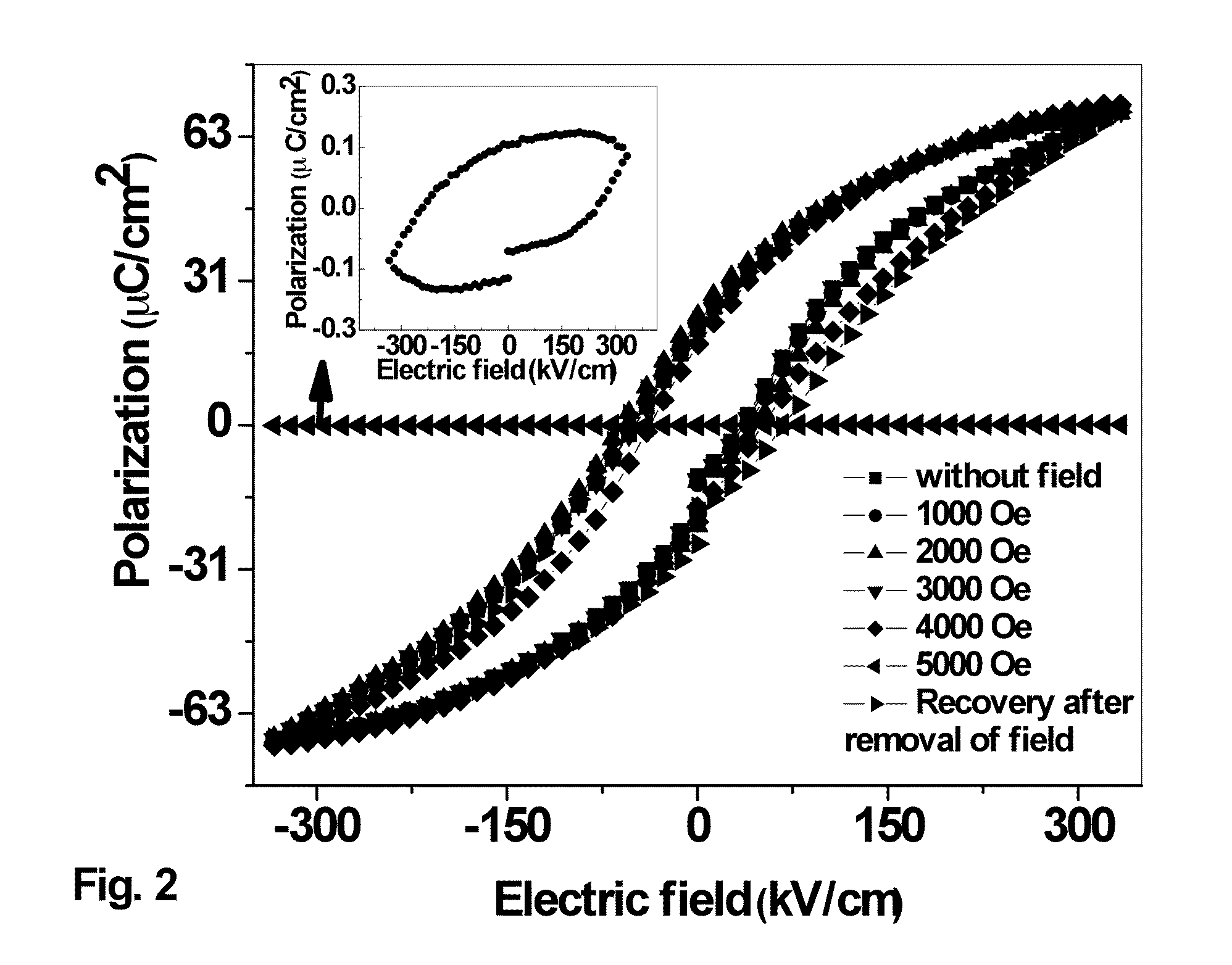Room-temperature magnetoelectric multiferroic thin films and applications thereof
a magnetoelectric multiferroic, thin film technology, applied in the field of room-temperature magnetoelectric multiferroic thin film and applications thereof, can solve the problems of high leakage, low me voltage coefficient, and unsuitable application of weak field sensor, and achieve well behaved and saturated c(v) hysteresis, the effect of low leakag
- Summary
- Abstract
- Description
- Claims
- Application Information
AI Technical Summary
Benefits of technology
Problems solved by technology
Method used
Image
Examples
example 1
Preparation and Properties of (PFWx-PZT1-x) (0.20≦x≦0.40) by Chemical Solution Method
Materials and Methods
[0050]Ferroelectric (PFWx−PZT1-x) (0.20≦x≦0.40) thin films were deposited on Pt / TiO2 / SiO2 / Si(100) substrates using chemical solution deposition (CSD). The high purity (>99.9%) precursor materials (i.e., lead acetate trihydrate, iron 2-4 pentanedieonate, titanium isopropoxide, zirconium isopropoxide and tungsten isopropoxide) were bought from Alfa Aesar and used for making stock solutions. For good quality films a (PFWx−PZT1-x) (0.20≦x≦0.40) solution of 0.2-0.3 molar concentration was spin coated at 3000 rpm for 30 seconds and pyrolyzed at 673 K for 2 minutes. This process was repeated several times in order to get desired film thickness. Rapid thermal annealing (RTA) was performed at different temperatures from 873 K-1023 K for different time intervals ˜60-300 seconds to get the desired phase and high density. The substrate consists of a layer of Si (about 350 μm thick), SiO2 (a...
example 2
Preparation and Properties of (PFWx−PZT1-x) (0.20≦x≦0.80) by Pulsed Laser Method
Materials and Methods
[0061]Stoichiometric ceramic targets of (PFWx−PZT1-x)(0.20≦x≦0.80) with 10% excess of lead oxide (to compensate for loss of volatile Pb) were synthesized by a conventional solid-state route. Three different compositions of (PFWx−PZT1-x) films with varying deposition temperature were fabricated by pulsed laser deposition (PLD) employing a KrF excimer laser (A=240 nm). The conducting La0.67Sr0.33CoO3 (LSCO) layer was grown on MgO (100) substrate at 873 K under an oxygen pressure of 300 mTorr, using a laser energy density of (1.8 J / cm2) and repetition rate of 10 Hz, followed by normal cooling in oxygen atmosphere. LSCO was used as bottom electrode for all kind of electrical measurements. The (PFWx−PZT1-x) layer was then deposited on the LSCO layer at 873 K under an oxygen pressure of 200 mTorr, using a laser energy density of (1.5 J / cm2) and repetition rate of 10 Hz. After deposition, (...
example 3
Fabrication of MMIS Device Structure of (PFWx−PZT1-x) (0.20≦x≦0.40) on p-Type Silicon
[0069]Materials and Methods:
[0070]To fabricate the MMIS structure, 6 nm SrTiO3 (ST) was deposited on a p-type Si(111) substrate by PLD technique. Attempts at fabrication of the structure by depositing amorphous SrTiO3 at low temperatures yielded much higher leakage currents, in turn giving unsaturated accumulation regions under the application of negative bias voltage. So instead crystalline SrTiO3 (6 nm) was grown at 973 K with 100 mTorr of oxygen atmosphere. Three different compositions of (PFWx−PZT1-x) films with varying deposition temperature were fabricated by PLD employing a KrF excimer laser (λ=240 nm). The (PFWx−PZT1-x) layer was then deposited on the ST layer at 600° C. under an oxygen pressure of 200 mTorr, using a laser energy density of (1.5 J / cm2) and repetition rate of 10 Hz. After deposition the (PFWx−PZT1-x) was annealed at 873 K for 30 minutes in oxygen at a pressure of 300 Torr. Fi...
PUM
| Property | Measurement | Unit |
|---|---|---|
| temperature | aaaaa | aaaaa |
| dielectric constant | aaaaa | aaaaa |
| temperature | aaaaa | aaaaa |
Abstract
Description
Claims
Application Information
 Login to View More
Login to View More - R&D
- Intellectual Property
- Life Sciences
- Materials
- Tech Scout
- Unparalleled Data Quality
- Higher Quality Content
- 60% Fewer Hallucinations
Browse by: Latest US Patents, China's latest patents, Technical Efficacy Thesaurus, Application Domain, Technology Topic, Popular Technical Reports.
© 2025 PatSnap. All rights reserved.Legal|Privacy policy|Modern Slavery Act Transparency Statement|Sitemap|About US| Contact US: help@patsnap.com



